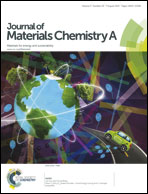Highly ordered 3D macroporous scaffold supported Pt/C oxygen electrodes with superior gas-proton transportation properties and activities for fuel cells†
Abstract
An oxygen electrode finds many applications in various electrochemical energy conversion devices such as fuel cells and metal–air batteries. Highly efficient gas–proton transportation at the electrode is very important to enhance the power density of these devices. Herein, we report the construction of a highly efficient oxygen electrode with substantially improved proton conductivity and gas transportation properties using three dimensionally ordered macroporous Nafion/Cs2.5H0.5PW12O40, 3DOM Nafion/CsHPW, scaffold supported Pt/C nanocomposites. The best results were obtained for cells with 3DOM Nafion/CsHPW with 10% CsHPW, achieving a maximum power density of 955 mW cm−2, 31% higher than 730 mW cm−2 for the cell with the conventional Nafion-binder based oxygen electrode. The proton conductivity of the 10% 3DOM Nafion/CsHPW catalyst layer is 1.56 × 10−2 S cm−1, 112% higher than 7.35 × 10−3 S cm−1 measured for the conventional catalyst layer with the Nafion binder. The results demonstrate the significant advantages of the oxygen electrodes with the Pt/C-3DOM Nafion/CsHPW architecture over the conventional Nafion-binder based ones, with the significantly enhanced proton conductivity of uniformly distributed CsHPW nanoparticles (NPs) and much better gas diffusion properties of the 3DOM architecture.



 Please wait while we load your content...
Please wait while we load your content...